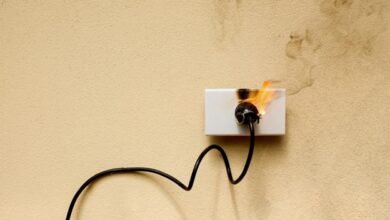How to Get Rid of Aphids on Indoor Houseplants
Get to know both the natural and chemical methods!

If you see aphids on one of your houseplants, you need to act fast since they can quickly infest all of your other plants. You can apply several methods to get rid of aphids from indoor plants.
Aphids on plants can be removed most quickly by spraying the plant leaves with a steady stream of water. It will get rid of aphids on plants without the need for chemical products.
The second thing you should do is put the infected plant in a separate area and clean the place where it was sitting very well. Check the other houseplants around it for aphids as well.
We’ll discuss various tested solutions for killing aphids from household plants without risking the health of your plants or family pets. Let’s get started.
Aphids are among the most harmful plant pests, but you may control them with physical measures, trapping crops, and helpful plants. Try one of these simple and safe techniques to get rid of aphids from indoor plants.
Homemade Aphid Spray – NEEM OIL
Neem tree oil is one of the most potent natural pesticides to kill aphids. For ages, people have relied on neem oil that is derived from neem tree seeds to keep insects and viruses away.
The oil disturbs the hormonal balance of most garden pests, making it hard for them to grow and reproduce.
What You Need…
- Put two tablespoons of pure castile soap in a gallon of water and use that to fill a spray bottle. Shake them well.
- Add one tablespoon of neem oil in it and mix properly.
How to Use?
To kill aphids on indoor plants, spray the neem oil mixture once a week when the sun isn’t too hot, like in the mornings or evenings. Shake the bottle well and lightly spray the plants.
Spray the neem oil mixture on the leaves and stems while wearing safety gloves. Apply only once every two weeks if using this as a preventative measure.
Careful…!
One thing to remember is that if used more than once a week, it will also kill helpful insects like ladybugs and praying mantises, which could worsen the plant’s aphid problem.
Homemade Aphid Spray – SOAPY WATER
Organic insecticidal soap is another effective home remedy for aphids on plants.
Either you can buy an organic insecticidal soap or make a homemade soapy water spray to get rid of aphids on houseplants.
What You Need…
- One teaspoon of mild organic liquid soap.
- One liter of warm water.
- Mix the items in a spray bottle and spray on aphids.
How to Use?
To ensure that all traces of aphids are eliminated, spray your plants regularly with a soap solution until you no longer see any activity.
The organic aphid sprays kill on contact but have no lasting effect.
Careful…!
Always test a spray on a leaf first to ensure it won’t harm your plants before using it on the entire plant.
Homemade Aphid Spray – RUBBING ALCOHOL
For the natural control of aphids on houseplants, rubbing alcohol can be used in place of pesticides.
This method involves treating an aphid infestation using rubbing alcohol or isopropyl alcohol.
What You Need…
- In this case, mix an equal quantity of water and rubbing alcohol in a spray bottle.
How to Use?
If your aphid problem isn’t too severe, a fast swipe of alcohol with a cotton swab is enough. If not, apply a spray to where aphids are most abundant and let it dry. Do this twice weekly until the bugs are gone.
This alcohol spray can also eliminate indoor millipedes, ants, and other insects.
Careful…?
If you are concerned about the effects of alcohol on plants, you can dilute it with water.
Warning: Using too much water will make the solution useless.
Homemade Aphid Spray – CAYENNE PEPPER
Cayenne pepper could be the solution if you don’t want to use harmful pesticides or prefer a more natural approach to aphid control. Aphids can be killed with the capsaicin found in cayenne pepper.
Procedure
- One teaspoon of cayenne pepper.
- 1 cup of water.
It also works if you have a hot, spicy chili pepper instead of cayenne pepper. Put water in a small bowl or spray bottle and add cayenne pepper.
How to Use?
Your indoor garden will be safe from pests if you soak the leaves and the soil around the plant’s base.
Homemade Aphid Spray- canola oil and baking soda.
Baking soda can easily kill pests that like to suck plant juice off of your plants.
What You Need…
- Spray bottle.
- 1 gallon of water.
- One tablespoon of baking soda.
- Two tablespoons of canola oil.
How to Use?
Combine all ingredients in a big spray bottle and apply evenly to the plant’s leaves.
Indoor plants that rarely encounter other insects benefit significantly from this method.
Oil coats and tears down insects’ exoskeletons, leaving them vulnerable to poisons. However, baking soda’s acidic properties make it easy to remove bugs from plants by wearing away their outer shell.
Careful…?
It’s best to use this product only on indoor shrubs or during the pests’ hibernation season (winter/spring) to protect beneficial insects in the garden.
Homemade Aphid Spray – Garlic oil
There are organic ways to kill aphids, so you don’t have to choose what’s readily available. Like other living things, bugs use their sense of smell to locate food. To keep unwanted pests away from your houseplants, try using garlic cloves as a repellent. Garlic has a strong odor that many insects find offensive.
What You Need…
- Several garlic cloves.
- Four teaspoons of vegetable oil.
- 2 cups of water.
- One teaspoon of dish soap.
- A spray bottle.
- Put the minced cloves, warm water, vegetable oil, and dish soap in a spray bottle and shake well. Shake until well mixed.
How to Use?
Spray the mixture all over the plant, including the leaf undersides.
The method is safer than applying commercial pesticides like pyrethrin because the components are all-natural and have no impact on the plant.
Sticky Stakes
Sticky stakes can also be used to get rid of aphids. Aphids will be captured on the sticky surface of these little wooden stakes. They are available online or at most garden supply stores. The aphids will land on the stake once you place them in the ground near the plant.
You may read: How to Get Rid of Gnats
Don’t worry if you notice aphids with wings on your houseplant. Get some sticky houseplant traps around your houseplants to catch any aphids flying about. Don’t get alarmed if you observe a lot of bugs in the sticky trap; they can be fungus gnats, which can also be caught in sticky traps.
Due to its ease of use and ability to capture numerous aphids in one location, many people have discovered that this method is the most efficient for getting rid of aphids on indoor plants.
Remove Parts or the Whole Plant
In some cases, removing the plant’s aphid-infested areas is the only option. After prolonged aphid contact, these damaged leaves need to be removed anyway; thus, removing them improves your plant’s quality.
Of course, a treatment plan and spray are still required. Moving the entire plant may be necessary for addition to removing parts.
To stop the spread of insects when there is a severe infestation, it is essential to separate your indoor plants from one another, especially if you have several of them. Put infected plants in a space that is separate from other plants, like a balcony or a room.
Mix with Some Essential Oils
In a nasty situation, essential oils can help you relax and enjoy the pleasant aroma. Essential oils are ideal for indoor plants and gardens since they kill aphids and repel most pests.
To make your natural repellent, you can use any of the four essential oils such as peppermint, rosemary, thyme, and clove. Create a mixture of all four, or use the recipe below to pick your preferred one.
What You Need…
- 8 ounces of water.
- 1 tsp Castile soap.
- 1 tsp essential oil.
A sprayer or spray bottle is the ideal liquid application method.
How to Use?
Cover the entire plant with the coating, then let it air dry. This solution kills both adult and egg aphids.
Diatomaceous Earth
Using diatomaceous earth (kieselguhr) is another efficient method for controlling insect pests in your houseplants. This white powder originates from fossilized sea organisms and plants.
Like other pest control methods, the insecticide dries out the bugs while protecting your plant.
How to Use?
Before adding powder, wet the plant to give it a grip. Dust the entire plant, making sure to reach the areas in between the leaves.
Try to cover as much of the plant as possible with the substance by sprinkling it on the leaves and soil. Apply powder to smaller or harder-to-reach plant sections using a clean makeup brush. For about a week, repeat this method every two to three days.
Once the infestation is gone, you can continue normal plant care.
Careful…?
- Don’t add diatomaceous earth to the flower petals. If you plan to keep your indoor plant outside, do so either as a quarantine from other potted plants or on a balcony until the aphid problem is resolved.
- When treating your shrubs and flowers, use food-grade diatomaceous earth.
- Beneficial pollinators like bees and butterflies could be harmed if the flowers are coated.
- Don’t forget to apply some around the plant’s base after treating the leaves and stem.
Chemical Insecticide
Using organic techniques to rid your houseplants of pests is the safest way, as you won’t risk harming the plants, even the weaker ones, or the pollinators that rely on them. However, in extreme cases of pest infestation, chemical insecticides may be the only option.
Insecticidal soap is recommended because it is powerful, easy to use, and effective against various plant pests.
Apply spray to all parts of the plant, including the undersides of leaves, twice weekly to avoid exposure to direct sunshine. Apply in the morning or evening or as directed on the bottle.
Add More Natural Predators
Aphids can also be managed by introducing some of their natural predators. This doesn’t mean inviting a group of ladybugs into your house. Even if you have a serious aphid problem, a single lady beetle will consume roughly 50 aphids every day.
Other predatory insects, such as lacewings, which consume about 200 aphids each week, are also helpful. They are also ideal for removing other pests like spider mites.
Lacewing eggs and ladybugs are available at most lawn and garden retailers. You can also reduce your aphids by planting catnip and other shrubs that attract predators like ladybugs.
Why Do Aphids Keep on Coming Back?
Aphids are drawn to plants that have tender new growth. That’s why it’s important not to overwater or over-fertilize your plants; doing so could make them more attractive to aphid infestations and have adverse effects.
How to Get Rid of Aphids Permanently?
Maintaining appropriate and regular care for houseplants is essential in preventing aphids since they are drawn to overfertilized, overwatered, and underwatered plants.
Overwatering is typically indicated by limp, soft leaves and moist soil, while more than an inch of dry soil and dry, crunchy leaves are signs of underwatering.
The greatest advice is to avoid putting stress on houseplants by moving them around excessively, placing them in drafty spaces, or fertilizing them excessively.
Aphids like weak plants, so keeping your plants healthy and growing is the best way to keep aphids under control.




